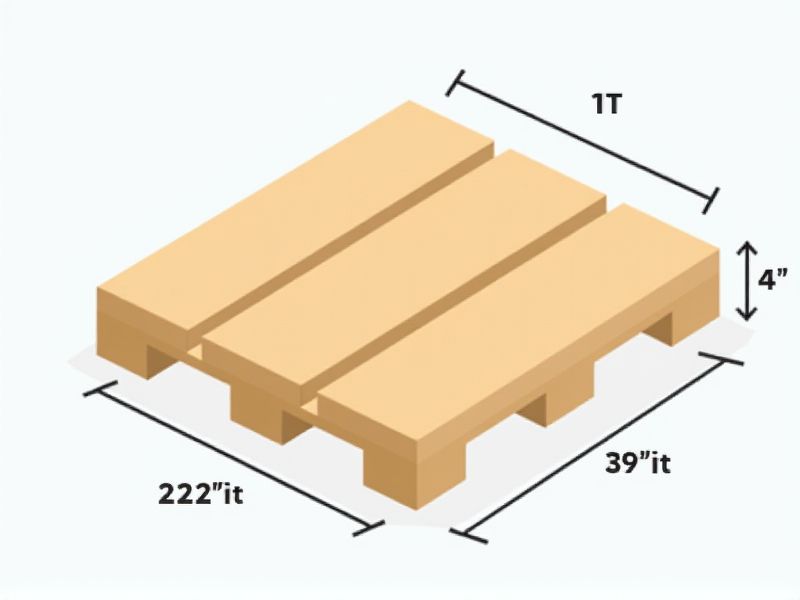
When working with pallets for shipping or storage, knowing the standard dimensions is essential for efficient planning and logistics. The most widely used pallet size, especially in North America, is 48 inches by 40 inches (1219 mm x 1016 mm). This size is commonly referred to as the GMA (Grocery Manufacturers Association) pallet and supports most racking and transportation systems. By using pallets with standard dimensions, you ensure greater compatibility with handling equipment and maximize space utilization in trucks and warehouses.
Euro Pallet
The Euro pallet, recognized by its dimensions of 1200mm x 800mm, is designed to facilitate efficient transportation and storage across Europe. Constructed from high-quality wood or environmentally-friendly materials, it can support a maximum load capacity of approximately 1500 kg, making it ideal for heavy goods. Featuring the EPAL logo, this standardized pallet ensures safety and reliability in logistics, with a distinct quality assurance mark. You can increase your operational efficiency by adopting the Euro pallet standards in your supply chain management.
American Pallet
The American standard pallet, often referred to as the GMA (Grocery Manufacturers Association) pallet, measures 48 inches by 40 inches and is constructed from wood, though plastic and metal variants are also common. This pallet design supports a weight capacity of approximately 2,500 pounds, making it ideal for transporting goods across diverse industries, particularly in grocery and retail sectors. Typically, when stacked, these pallets allow for an efficient storage solution, optimizing warehouse space by utilizing vertical storage. Understanding the specifications and benefits of the American standard pallet can significantly enhance your logistics and inventory management strategies.
Australian Pallet
The Australian standard pallet is specifically designed to support heavy loads, with a typical weight capacity of up to 2,500 kilograms. Measuring 1,200 mm by 1,000 mm, this pallet is engineered for compatibility with most Australian freight systems and transportation methods. The Australian Wood Packaging Certification Scheme (AWPCS) ensures that these pallets meet stringent pest and disease control requirements, promoting biosecurity. By choosing to use this standardized pallet, you can enhance efficiency and safety in your logistics and supply chain operations.
Pallet Height
The standard height of a pallet is typically 4 inches (10.16 cm), which is crucial for compatibility with various storage systems and material handling equipment. Pallet heights can vary based on industry standards, but common sizes include 48x40 inches (121.92x101.6 cm) for North America and 1200x800 mm for Europe. Adjusting your pallet height may impact loading efficiency and stability, affecting warehouse operations and transportation costs. Understanding these specifications ensures optimal storage solutions and compliance with industry regulations.
Pallet Width
Standard pallets typically feature a width of 1,200 millimeters (47.2 inches), designed to optimize space and enhance storage efficiency in warehouses and transportation. The dimensions accommodate various load types, making them versatile for different industries, from retail to manufacturing. By adhering to the international standardization guideline (ISO 6780), these pallets facilitate seamless handling and interchangeability among various logistics systems. Ensuring your operation relies on standardized pallet widths can significantly improve supply chain efficiency and reduce overall operational costs.
Pallet Length
The standard length of a pallet typically measures 48 inches, accommodating a vast range of storage and transportation needs. This dimension allows for efficient use of space in both warehouses and shipping containers, optimizing logistics operations. Pallets with a length of 42 inches or 40 inches are also common, providing flexibility for different types of products and handling equipment. Properly adhering to these standard lengths can enhance load stability and improve your supply chain efficiency.
Pallet Weight Capacity
The standard pallet typically supports a weight capacity ranging from 2,500 to 4,500 pounds, depending on the material and design. Wooden pallets are common, offering robust strength due to their solid construction, while plastic pallets provide a lightweight alternative with moisture resistance. The dimensions of a standard pallet usually measure 48 inches by 40 inches, making them suitable for various industries, including logistics and warehousing. Ensuring that your chosen pallet meets these standards is crucial for optimizing loading, transport efficiency, and safety in your operations.
Pallet Material
The standard for pallets primarily emphasizes material quality, ensuring durability and safety in transportation and storage. Wood, plastic, and metal are the most common materials used, with wood pallets being the most prevalent, accounting for approximately 95% of the market. Plastic pallets, although comprising a smaller segment, offer advantages such as recyclability and hygiene, making them ideal for industries like food and pharmaceuticals. You should consider these material characteristics when selecting a pallet to enhance your logistical efficiency and meet industry standards.
Stackable Pallets
Stackable pallets, essential in warehousing and logistics, optimize space utilization by allowing for vertical storage. The standard dimensions for a stackable pallet typically range from 48 inches by 40 inches, with a weight capacity of up to 2,500 pounds. These pallets are designed to interlock securely, minimizing slippage during transport and enhancing product stability. By incorporating stackable pallets into your operations, you can improve efficiency and reduce costs associated with storage and handling.
International Standards Compliance
The standard pallet dimensions are typically defined as 48 inches by 40 inches, aligning with international logistics and transportation requirements. These pallets are designed to support an impressive weight capacity of up to 2,500 kilograms, ensuring load stability during shipping. Compliance with international standards, such as ISO 6780 and EN 13698, guarantees that pallets meet safety and quality benchmarks essential for global trade. By utilizing standardized pallets, you enhance efficiency in warehousing, reduce handling costs, and optimize space utilization in containers and trucks.
